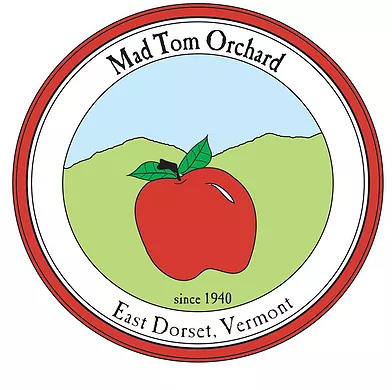
We have fourteen different varieties of apples.
Here they are grouped by when they ripen:
Early Season (early September)
Zestar, Sansa, Ginger Gold
Mid Season (later in September)
McIntosh, Gala, Cortland, Honeycrisp, Macoun, Fuji, Bondee (planted 2017 – small harvest starting 2019)
Late Season (October)
Crimson Crisp, Empire, Golden Delicious, Northern Spy
Apple Calendar
| Variety | Ripens | Description | Best Uses |
|---|---|---|---|
Zestar |
usually first weekend in September |
From the University of Minnesota which gave us Honeycrisp – introduced in 1999. Sweet, tart and juicy. It will keep covered in refrigerator for six to eight weeks. | Fresh eating, makes a great pie with a spicy taste. A new favorite for us!! |
Ginger Gold |
usually first weekend in September |
Discovered in a Virginia orchard after Hurricane Camille – a survivor – resembles Golden Delicious but juicer | Fresh eating – favorite of local bakers. Use within a few weeks. Slow to brown, so good in salads |
Sansa |
usually first weekend in September |
From a cross of Gala with Akane, a Japanese apple. Gala type flavor, sweet. Some say its pear like. | Fresh eating – kids like it’s sweet taste and small size – a good lunch box apple. |
McIntosh |
usually second week in September |
The premier New England apple popular since its introduction from Canada in 1870. Freshly picked Macs are juicy, crisp and aromatic. | fresh eating, apple sauce & apple crisp. For pies, cut slices thick because they soften. Cortland will make a firmer pie. |
Gala |
usually second week in September |
A solid blush strain of Gala originating from New Zealand in the 1960’s. Mild, sweet flavor, crisp and firm. | Fresh eating, dries well, also bakes and stores for weeks in refrigerator. Kids go for it. |
Blondee |
usually second week in September – recently planted – quantities limited |
A new variety from Michigan. It is a yellow-skinned, Gala-type apple | Fruit is very good for fresh eating, has a smooth finish and crunchy texture. When we get more production, we will see how it works for baking. |
Honeycrisp |
mid September |
Introduced by University of Minnesota in the 1990’s and very popular. Crisp and juicy with a rich flavor | Best for fresh eating. Some people bake and make apple sauce with it – it tends to stay very firm. |
Cortland |
mid to late September |
From New York state apple program introduced in 1898. Cross between McIntosh and Ben Davis. Sweeter than Mac, slow to brown, firm. | Premier baking apple. Excellent for salads (stays white due to slow browning). Late season Cortlands make beautiful apple sauce. |
Fuji |
mid to late September |
Popular in Japan and China, but actually has American parents Ralls-Janet and Red Delicious. Firm, sweet – we grow a variety called Daybreak Fuji that ripens earlier than standard Fuji. | Fresh eating, keeps well. Supply may bed limited in some years because it tends to be biennial. |
Macoun |
mid to late September |
another New York state apple, introduced in 1923. Parents are McIntosh and Jersey Black. Firm, aromatic and juicy. Can be pronounced Mac-cown (rhymes with noun or Mac-coon. My father pronounced it Mac-cown, so that is the way I say it. | Fresh eating, excellent for pies (holds shape better than McIntosh) and makes great pink apple sauce, if you leave the skin on. |
Empire |
mid to late September |
another apple from N. Y. state ~ 1966. McIntosh crossed with Red Delicious. Crisp, white flesh, sweet. | Fresh eating – keeps well. Also good for baking, cider and other cooking. |
Crimsoncrisp |
early October |
developed by Rutgers & Purdue – disease resistant – available ~ 1995. Must wait for it to ripen to get its great sweet tart flavor. Very firm – keeps VERY well. | wonderful for fresh eating – flavor develops more a few weeks after harvested |
Golden Delicious |
mid October |
A chance seedling from West Virginia – probably from Grimes Golden. In 1914 Stark Nursery bought the tree for $5.00. Crisp and juicy. | Mild flavor, a good apple for pie or sauce as well fresh eating. Keeps well in refrigerator. |
Northern Spy |
October |
Sprouted from seed near Canandaigua NY ~ 1900. Very slow to begin to bear fruit and tends to be biennial. Usually picked green and allowed to ripen in storage. | a classic pie apple – stays firm when baked. Good for baked apples as well as pies. Old timers keep it over winter in root cellars. |
